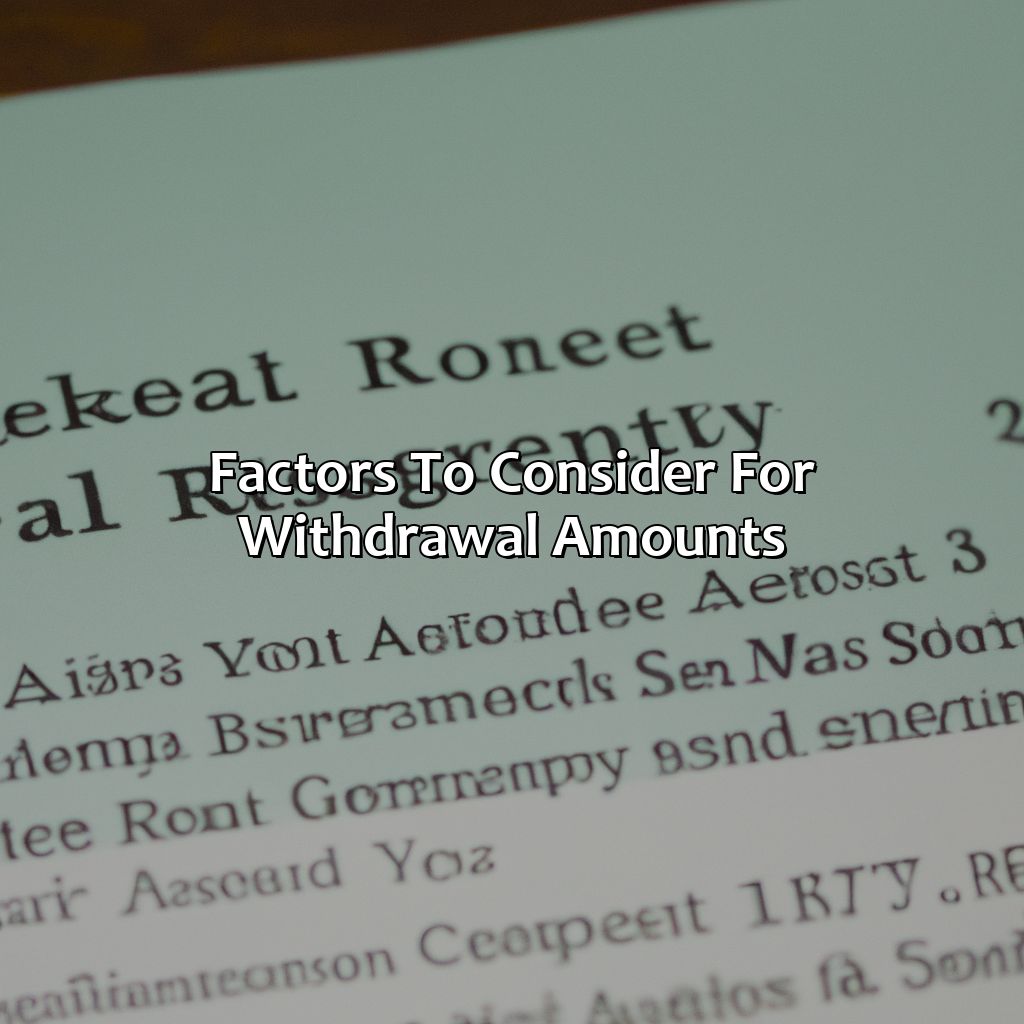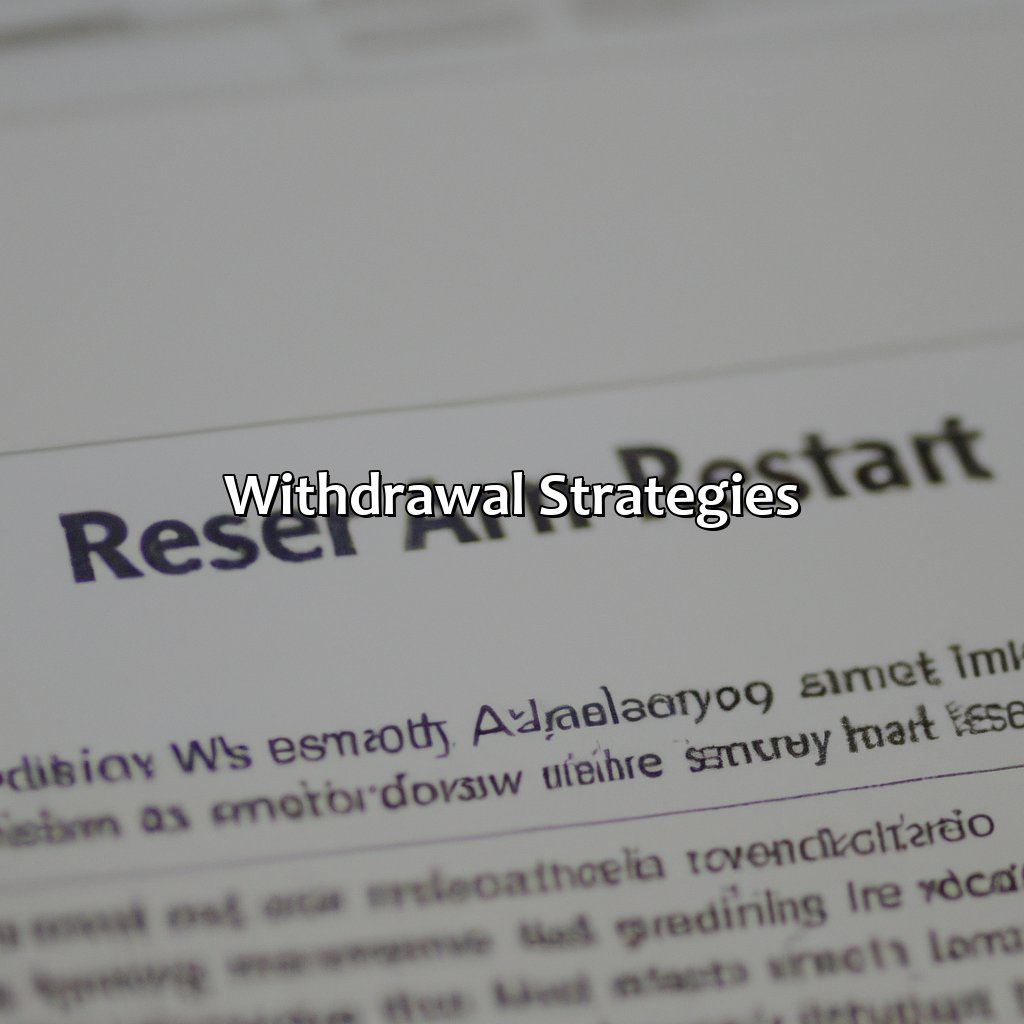How Much Can I Withdraw From My Retirement Account?
Key Takeaways:
- Factors such as age, retirement goals, tax implications, and account type can impact the amount you can withdraw from your retirement account.
- Withdrawal strategies such as systematic withdrawals, required minimum distributions, and emergency withdrawals can help you optimize your retirement income and manage your tax liabilities.
- Consulting with financial professionals can help you make informed decisions about your retirement account withdrawals and ensure your long-term financial security.
Are you worried about depleting your retirement funds too quickly? You can maximize your retirement savings by understanding how much you can withdraw from your account. In this blog, you’ll learn how to calculate and manage withdrawals so you can make the most of your retirement.
Factors to Consider for Withdrawal Amounts
Weighing Age and Retirement Goals, Tax Implications, Account Type, and Withdrawal Rules is key to determining the best withdrawal amount from your retirement account. Each factor can impact the amount you can withdraw. All of these subsections will provide more insight.

Image credits: retiregenz.com by Yuval Washington
Age and Retirement Goals
As we plan for retirement, it is vital to consider our age and the goals we have set. These factors help determine the amount one can withdraw from their retirement account without running out of money during their golden years. It is essential to balance the withdrawal amount with long-term goals, health, and life expectancy.
One must weigh the retirement goals carefully while considering age before taking any withdrawals. Early retirees may opt for smaller withdrawals as they have more extended time to allow their accounts to grow. Older retirees may take bigger withdrawals as they need to enjoy their retirement years. Therefore, age plays an integral part in determining how much one should withdraw from their retirement accounts.
In addition, when deciding on a withdrawal amount, individuals must keep in mind that they might live longer than expected. This makes it necessary to balance living comfortably while ensuring one’s financial security in the coming years. As such, withdrawing too much too early or spending excessively can lead to a shortage of funds when most needed.
It’s essential to seek expert advice when making critical decisions on withdrawal amounts from your retirement account. Consulting a financial advisor can help give personalized advice regarding how much money is enough and prevent any regrets later on.
By considering age and setting clear goals when planning for retirement, coupled with sound advice from experts in the finance industry, individuals can make informed decisions on withdrawals from retirement accounts without any fear of missing out in their golden years.
Saving for retirement is like playing Russian Roulette, except with taxes instead of bullets.
Tax Implications
Understanding the tax implications is crucial when deciding how much to withdraw from a retirement account. The amount of taxes you will pay depends on your age, type of account, and other factors.
For traditional retirement accounts such as 401(k) or IRA, withdrawals are generally taxed as income. If you withdraw before the age of 59 and a half, you may also be subject to an additional 10% penalty tax. Roth accounts, on the other hand, are taxed differently – contributions are made with after-tax money, and qualified withdrawals are tax-free.
It’s important to consider your current tax bracket and potential future tax rates when deciding how much to withdraw. You may want to spread out withdrawals over multiple years or adjust the amount based on changes in your financial situation.
Remember that taxes are only one factor to consider – other factors such as investment returns, inflation rate, and overall retirement goals should also be taken into account when making withdrawal decisions.
According to Forbes’ contributor William Baldwin (2019), “You may have heard that some wealthy people manage never to pay any taxes. But I bet they’re not among their own trusted advisors.“
Remember, rules are meant to be broken, but not when it comes to withdrawing from your retirement account.
Account Type and Withdrawal Rules
When planning to withdraw from your retirement account, it’s essential to consider the account type and withdrawal rules. Let’s take a look at some relevant factors:
Account Type and Withdrawal Rules
The following table summarizes the key details of each account type:
| Account Type | Age at Which Penalties Apply | Maximum Annual Withdrawal |
|---|---|---|
| Traditional IRA | 59.5 years old | None |
| Roth IRA | — | Contributions Only |
| 401(k) | 59.5 years old | None if Still Employed |
Unique details that should be kept in mind are the penalties for early withdrawals, which vary based on the account type and age of withdrawal. Additionally, withdrawals can affect your taxes, so understanding your tax bracket is also important before deciding on a specific amount.
Don’t risk missing out on potential lifelong income by failing to plan correctly. Do thorough research or consult with a financial advisor to determine the best withdrawal strategy for your specific retirement account type. Retirement may be the only time when it’s socially acceptable to withdraw without adding anything to society. So let’s strategize wisely!
Withdrawal Strategies
Retirement savings planning? Know the withdrawal strategies.
Ask yourself, “How much can I withdraw from my retirement account?” Think systematic withdrawals, required minimum distributions, and emergency withdrawals. Find what works best for you. Dive in and explore each strategy!

Image credits: retiregenz.com by Harry Jones
Systematic Withdrawals
A retirement account includes a variety of investment options that can be liquidated through a planned and well-executed withdrawal strategy. The literal meaning of ‘Systematic Withdrawals’ refers to the scheduled disbursement of funds from a retirement account over a specified period, according to an agreed-upon formula based on the participant’s age and the total balance in their account. A convenient aspect of this approach is that it provides the individual with more control over their financial standing by allowing for flexibility when taking withdrawals.
Retirement planners suggest using the “4% rule” to calculate systematic withdrawals. This approach involves drawing down approximately 4% of your portfolio annually at retirement while adjusting that percentage for inflation regularly. You can also opt for other safe or aggressive withdrawal rates based on market returns and inflation. Withdrawing 4% again poses some risk as market fluctuations could pose challenges occasionally.
As part of creating an effective withdrawal strategy, you should consider several factors like inflation, tax implications, and longevity risks. Inflation erodes purchasing power over time, so ensure you consider ways you can hedge against this risk to protect your reliance on investments alone. Also, consider the taxes applicable to each type of retirement plan and adjust accordingly.
Annie Fernandez opted for systematic withdrawals when she retired after working forty years as an art teacher in California. While she found it challenging planning her finances in her younger years, taking withdrawals systematically gave her checkbooks more stability and prevented under- or overspending habitually.
If I have to take a required minimum distribution from my retirement account, can I at least require a maximum amount of small talk during holiday dinners?
Required Minimum Distributions
As a retiree, you may wonder how much you can withdraw from your retirement account. One crucial factor to consider is the amount of money the government requires you to withdraw every year, commonly known as Required Minimum Distributions (RMDs). RMDs vary based on your retirement account balance and life expectancy. Failure to take out the required distribution may result in hefty penalties, making it essential to stay current with RMD requirements.
To ensure that you are withdrawing the correct amount during retirement, it is vital to understand RMD regulations and guidelines. Several factors can impact your RMD calculation, including changes in tax laws. If you have questions about calculating your RMD or need assistance navigating this complex process effectively, consider consulting a financial advisor who specialized in retirement planning.
One way to optimize your investment experience is by regularly reviewing and adjusting your withdrawal strategy based on individual needs and resources. By doing so, not only will you reach your financial goals faster, but also maximize your retirement fund’s longevity while avoiding consequences from inaccurate withdrawals.
Just remember, an emergency withdrawal from your retirement account is like using a fire extinguisher on a campfire – it’s not ideal, but sometimes you gotta do what you gotta do.
Emergency Withdrawals
When unforeseen catastrophes hit, there’s always room for emergency retirement withdrawals. This is a critical financial move that requires careful consideration and close interaction with the relevant parties to navigate the ins and outs.
Here is a 5-step guide on how to go about it effectively:
- Start by assessing your monetary requirements to determine how much money you will need.
- Examine your investment accounts to see which ones offer pension cash-outs. Certain accounts might not allow it, while others may have restrictions.
- Communicate with your plan administrator or financial advisor to obtain details on the withdrawal options available to you.
- Fill out your application for withdrawal paperwork, ensuring that all of your forms are complete and accurate prior to submission.
- Once your request has been granted, take the funds necessary for your emergency and leave the rest in place- try using a cash cushion in case you require more later on.
It’s crucial only to take out what you absolutely need since frequently withdrawing large sums can result in severe future consequences. People should be wary of taxes, delays, drawbacks (early distribution fines), and potentially long-term impacts on investment development.
Once all decisions have been made regarding the retirement plan withdrawal essentials, the best course of action may necessitate consulting with legal counsel or estate planners since numerous ramifications could extend far beyond this brief discussion.
To give an instance: Becky was unable to pay her mortgage as she lost her job during the pandemic. She rummaged into her 401K retirement account under emergency-retirement-wallowed-necessity terms approved by Internal Revenue Service (IRS). However, after assessing all qualified expenses for these distributions such as food delivery services, rent, and other bills like car payments she ended up taking less pay than she originally intended.
No doubt, crucial life occurrences require quick financial solutions; implementing emergency retirement withdrawals necessitates care, diligence, and careful consultation with the relevant parties.
Consulting with financial professionals is like asking a magician for investment advice – they both know how to make your money disappear.
Consulting with Financial Professionals
Consulting with financial experts can help you make informed decisions when it comes to withdrawing funds from your retirement account. These professionals are equipped with the knowledge and experience to guide you on the optimal withdrawal strategy based on your unique financial situation. They can also help you navigate the often complex rules and regulations governing retirement account withdrawals, including tax implications and penalties.
It is important to note that while financial professionals can provide valuable advice, it is ultimately up to you to make the final decision on how much to withdraw from your retirement account. However, consulting with experts can help you make a more informed decision and avoid costly mistakes.
Pro Tip: Before making any significant withdrawals from your retirement account, it is advisable to consult with a financial expert to ensure that you are making the most financially sound decision based on your specific circumstances.

Image credits: retiregenz.com by Adam Arnold
Five Facts About How Much You Can Withdraw From Your Retirement Account:
- ✅ The Internal Revenue Service (IRS) sets annual limits on how much you can withdraw from your retirement accounts without facing penalties. (Source: CNBC)
- ✅ For 2021, the annual contribution limit for a 401(k) plan is $19,500 for individuals under 50 years old and $26,000 for those 50 and older. (Source: Investopedia)
- ✅ Traditional IRA and Roth IRA have different withdrawal rules and tax implications. (Source: Fidelity)
- ✅ The required minimum distribution (RMD) is the minimum amount you must withdraw from your retirement account every year once you reach age 72. (Source: IRS)
- ✅ Withdrawals from your retirement account may be subject to income tax and early withdrawal penalties if you withdraw before age 59 1/2. (Source: AARP)
FAQs about How Much Can I Withdraw From My Retirement Account?
How much can I withdraw from my retirement account?
The amount you can withdraw from your retirement account depends on various factors. These include your age, the type of retirement account you have, and any penalties or taxes you may face. It’s important to consult with a financial advisor to determine the best withdrawal strategy.
What is the minimum amount I can withdraw from my retirement account?
The minimum amount you can withdraw from a retirement account varies depending on the type of account you have and your age. For example, with a traditional IRA, you must start taking required minimum distributions at age 72. Failure to withdraw the minimum amount can result in a penalty.
Can I withdraw more than the minimum amount from my retirement account?
Yes, you can withdraw more than the minimum amount from your retirement account. However, keep in mind that withdrawing too much can result in additional taxes and penalties. It’s important to have a well-thought-out withdrawal strategy to avoid these potential pitfalls.
Is there a limit to how much I can withdraw from my retirement account?
There is no limit to how much you can withdraw from some retirement accounts, such as Roth IRAs. However, other retirement accounts, such as 401(k)s, may limit the amount you can withdraw each year. It’s important to be aware of these limits when planning your withdrawals.
How can I avoid penalties when withdrawing from my retirement account?
To avoid penalties when withdrawing from your retirement account, make sure you’re following the rules for your specific account type. For example, with a traditional IRA, you must start taking required minimum distributions at age 72. Failure to withdraw the minimum amount can result in a penalty. It’s important to consult with a financial advisor to ensure you’re following the necessary guidelines.
What are the tax implications of withdrawing from my retirement account?
Withdrawing from your retirement account can have tax implications, as the money may be subject to income tax. Additionally, withdrawing from a traditional IRA before age 59 1/2 can result in a penalty. It’s important to consult with a financial advisor to determine the best withdrawal strategy to minimize any potential tax implications.



